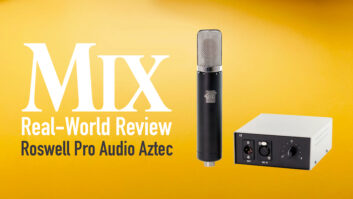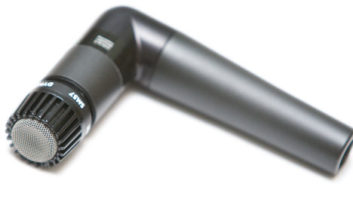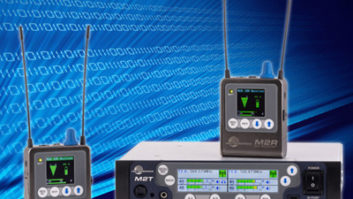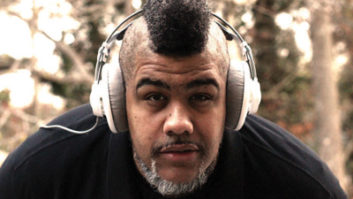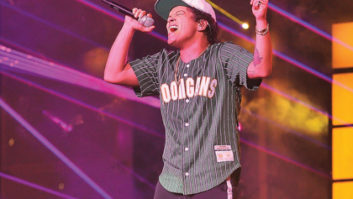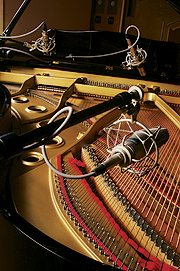

Guitarist Andrés Segovia said, “The piano is a monster that screams when you touch its teeth.” At the extreme, this is true, as anyone listening to pianist McCoy Tyner would agree. Though at the same time, the piano can display the most delicate of musical emotions, as evidenced in Beethoven’s piano concertos. Spanning just over seven octaves, from 27.5 Hz to 4,186 Hz, the piano offers an array of dynamics and frequencies virtually unparalleled in any other instrument. Accurately capturing the ferocity and nuance of this beautiful beast for others to hear is left to the recording engineer, who has the mission of choosing the correct tools for the job. This feature will deal mostly with effective techniques for recording the grand piano.
Figure 1: Adding a third mic to a stereo pair can help capture the piano’s low range.
photo: Chris Bailey
IT ALL STARTS WITH THE INSTRUMENT
It goes without saying that a tuned instrument makes for a better recording, and this is especially true with pianos. An out-of-tune piano will affect all of the other players in the ensemble. They all tune to the instrument and, more importantly, they “vibe” off of its power and range. This vibe filters down to the visceral level, and if the instrument is out of tune, then it can sour and color the performance of even the most seasoned players.
Unlike tuning a guitar, bass and drums, piano tuning is rocket science and should be left to professionals. If you’re interested in the mechanics of tuning and piano maintenance, which is certainly a deep subject, check out The Musician’s Guide to Acoustics (Campbell and Greated), which gives a nice guide to tuning techniques. Be aware that moving the instrument and changing the room temperature will affect a piano’s tuning. Be sure to move the instrument to its proper position before the tuner shows up. In addition, the night before the session, set the air conditioning to a comfortable level and leave it there. Maintaining a consistent environment will help keep the instrument stable.
It’s a good idea to get into the room before recording (and tuning) to check out the instrument. Work the pedals and listen for squeaks; if you don’t play, find someone to play the instrument while you assess it for action problems, inconsistencies or other random non-musical noises. If nothing else, this will give you something to address when the tuner shows up so these issues can be fixed before the downbeat.
MANY PATHS TO PIANO PERFECTION
Once the basics of tuning and maintenance have been addressed, the recording process can start, and that means choosing and placing your “weapons.” But first, it’s a good idea to hear what the instrument sounds like live from the listener’s perspective, especially when recording a piano you’re not familiar with. Engineer Hank Cicalo, who’s recorded the pianos of Michael Feinstein and Roger Williams, among others, likes to find out how the piano sounds in the studio and then translate that sound to the control room. “If I go to a strange studio where I don’t know the piano, I like to get there early when the tuner is there so I can hear the piano physically in the room,” he says.
Low-profile mics such as DPA’s 3521 cardioid stereo kit are ideal for closed-lid situations.
photo: Chris Bailey
When choosing mics for the job, it’s best to use matched pairs, but as you’ll read below, rules were made to be broken. The rules of placement are ones you may already be familiar with: X/Y, ORTF, spaced pair and Blumlein techniques all work great when recording piano. The variations come with the placement of these arrays in relation to the soundboard and piano. This is where it’s important to keep in mind what kind of timbre the music asks for. For instance, on a Bruce Hornsby record, the piano would sound bright and in your face, whereas a piano from the Beethoven biopic Immortal Beloved‘s soundtrack would be more distant and dark. Certainly, close-miking the piano where the hammers hit the strings would not let the instrument “breathe” enough for a classical recording, but it just might be the ticket for a pop recording. Other questions to ask: Is the instrument being performed solo? With a vocalist? In a band setting? Surrounded by other non-acoustic keyboards? All of these factors can determine how best to mike the piano.
For starters, an X/Y array or spaced-pair mics placed using the 3-to-1 rule work nicely when situated above where the hammers strike the strings. These close-miking techniques give you a good left/right picture of the instrument and capture a great amount of detail. Think of it more as a bright and in-your-face pop sound rather than a traditionally full jazz or classical tone. The balance of the instrument depends on where the mics are placed. To be sure his mics are balanced across the full breadth of the piano’s range, Cicalo places the mics, then has the pianist play an arpeggio from middle C up the keyboard, then from middle C down (see “The Story Behind the Sound” sidebar below for more on Cicalo’s tried-and-true techniques.) This way, from the control room, he can hear if the mic arrangement is providing a balanced picture of the piano and if any further adjustments are necessary.
If the piano’s low end is not being represented by the stereo mic pair, a third mic can be placed at the bottom of the keyboard range, close to the strings. This can be panned center to fill out the middle and bottom end of the instrument (Fig. 1).
Another technique that will render a phase-accurate stereo picture is ORTF. This configuration involves two mics placed approximately 17 cm apart (meant to simulate the space between your ears) at an angle of 110 degrees. Erik Zobler, George Duke’s engineer, uses this technique but adds a twist when recording Duke’s Bösendörfer concert grand piano. He uses a standard ORTF pair right at the open side of the piano and about 30 percent of the way up from the edge. He tries to use two of the same mics if possible, but in a lot of cases, he uses Duke’s stock AKG C12 and another C12 that has been modified with a Stephen Paul capsule. He’s found that the two mics sound quite different from each other, but he uses the personality of the mics to favorably accentuate the sound of the Bösendörfer. “The Stephen Paul mic is brighter, so I put that on the low side of the piano, and the stock C12, which is more mellow, I put on the high side of the piano,” he says.
The ORTF array can be moved back a few feet from the edge of the piano if you want to get more of the room tone in the recording. Of course, this means you have to have a room worth recording in. Keep in mind that when you add the room into the same mics that are providing the main piano sound, the combination is permanent, whereas you can always simulate a room nicely with a good quality reverb if you go the safe route and keep the mics close to the instrument. Another option is to use two pairs of mics: a close pair for presence and another pair in the room. The pair that’s backed away can then be added to taste during the mix and also leaves you options for a surround mix at a later date.
As with miking any instrument, placing the preamps closer to the source can keep you from losing quality due to line loss. Making a long cable run at line-level is always preferable than making one at mic level. So putting the preamps in the room with the piano is good practice. Zobler uses preamps from Mastering Labs, DeMedio or Boulder and runs them to the control room with high-quality cable.
A Blumlein pair — two figure-8 mics in an X/Y array — makes for an effective stereo pair that allows some of the room sound into the recording. Ribbon mics are an especially good choice for recording in Blumlein, especially if the part is percussive. Not only do you get a great stereo picture, but the natural tendency of the ribbon is to round out any sharp transients, making for a naturally compressed sound. An easy Blumlein configuration can be achieved with a stereo ribbon such as the AEA R88 or Royer SF-24.
LIVE RECORDING TECHNIQUES
Often, when recording piano in a live or broadcast setting, the lid must be closed for aesthetic or line-of-sight reasons, making it difficult to get an “open” sound. This situation calls for a special set of tools, namely miniature mics and those designed for low-profile use. The DPA 3521 compact cardioid stereo kit is designed for this task. It comes with either omni or cardioid capsules (4021 or 4022) and includes two types of mounts, either individual mini goosenecks or a slick stereo bar that allows either ORTF or X/Y placement. The set also includes two very strong magnets that the mounts screw onto, making it easy to precisely place the mics and not worry about them moving around. Each capsule slides into a rubber shock-mount, providing isolation. DPA even has a budget solution in its 4061 miniature microphone. These little guys come with a sticky mount and a magnetic mount that can be used to mount the mic on the lid of the piano or magnetically to the harp. I’ve used them on piano, guitar and bass, and the sound is remarkable for such a small mic.
Another example of recording with the lid closed is Leslie Ann Jones’ technique for miking Feinstein’s live piano. She uses a pair of Neumann KM100 bodies with cardioid capsules. (See the sidebar featuring her work with Petronel Malan below.) She favors the stereo set that lets the user disconnect the capsule from the body, leaving just a wire in-between, allowing her to place the capsules in a tight space. In addition, the system comes with a stereo bar that she uses to set up the mics in an X/Y pair. Jones places the bar with the capsules on some foam inside the piano, puts the mic bodies on the floor and closes the lid, and then runs the signal through Grace 201 preamps and a Summit EQP 100 tube EQ. Although recording with the lid closed is not acoustically ideal because of unwanted resonance, this particular method works in certain situations. “You may be able to tell the lid was closed if you soloed the piano, but in the context of a band or an orchestra, if you add some reverb, you’d never know the lid was down and the piano was close-miked,” Jones explains.
In a live sound stage setting where specialized tools aren’t available, you can use gaffer’s tape to mount mics directly to the piano’s struts, hopefully with some foam or other material to help isolate the mics from vibrations traveling up from the floor. Keep in mind that the piano’s soundboard is meant to resonate, and that means it can resonate from external sources and from the piano. The live mixer must then walk the line between EQ’ing the piano thin enough to eliminate low-end leakage from the stage while not sounding too thin.
In a studio setting, recording a performer’s pianos and vocals at the same time can be problematic, especially if you keep the lid closed for vocal isolation. In this situation, Jones and engineer Dann Thompson at Skywalker Sound created a drape by spreading a piano blanket between two mic stands and letting it hang just behind the music stand on the piano. This setup allowed them to keep the lid open for the best piano sound while providing vocal isolation.
Another live-in-studio approach that could present leakage problems is when recording a piano trio (piano, drums and upright bass) with a vocalist in the same room. While acoustically challenging, this technique can let the band play more dynamically without using headphones, and performances end up sounding much more “live” than with a traditional isolated studio recording. As for leakage, some placement tricks and mic choices can make it work for you instead of against you. For instance, place the drums behind the piano on the backside of the open lid as far away as possible. Next, place some gobos in front of the bass to provide some isolation from the drums and piano, and then place the singer close to the piano’s open lid for easy pitch reference. Surprisingly, using high-quality omni mics with very accurate off-axis response can help keep the leakage sounding good and usable. Having all the players within ear and eyeshot of each other, just as they would be in a club, makes for the best possible situation for your recording and keeps the players comfortable.
SAMPLING RATES AND FORMATS
Your choice of converters, sampling and bit rates and recording format can greatly affect the outcome of your recording. You can capture the best recording possible but later become victim to a bad sample rate conversion or have jitter introduced through some bad clocking down the line. To help prevent this, stick to what you know will sound good later on — so much depends on what happens later. For instance, if the project will be edited or mixed elsewhere, you have to be sure those facilities can handle the format you give them. If you don’t know, it’s often better to provide a great-sounding recording at 16-bit/44.1 kHz.
To further hedge your bets, especially if you’re recording the piano as a solo instrument, you could record the same performance at different formats and sampling rates — even analog and digital. This gives you an “insurance” copy of the recording or just something extra for archival purposes.
You could record your safety to DSD format or at 192 kHz. Tascam’s DV-RA1000 DSD/high-definition CD recorder is an interesting and inexpensive option to record at higher rates. When talking about sampling rates, ultimately, the goal is to maintain your original rate as long as possible throughout recording, editing and mastering, waiting to downsample if necessary at mastering when sample rate converters and converters in general tend to be more high end.
IN THE MIX
How you pan the piano can enhance or detract from how the listener perceives the instrument in the final product. Just because you can pan the stereo image fully to the left and right doesn’t mean you should. In fact, panning a stereo piano hard-left and right can make for an unnaturally huge stereo picture and, ultimately, a disjointed listening experience. Tucking the piano in tighter to the center or even to one side can give it the space it needs to be heard in the track. As for panning the keyboard, when using an X/Y or spaced pair above the hammers, the left-to-right orientation is to taste, with the player’s perspective being a popular choice. If the mics are pulled back from the instrument, then audience perspective is a good way to go.
One interesting and unconventional use of panning can be found on the CD Give by the Bad Plus. Engineer Tchad Blake panned the piano widely across the left, the drums across the center and the bass to the right, giving the listener the ability to fully hear what each player was doing without the instruments masked by the other. It is a startlingly simple solution to an age-old problem: How do you give each instrument enough space in the stereo image so it can be heard?
Keep in mind that the piano is not only a tonal instrument, but one that can exhibit a wide range of dynamics. A bit of smooth compression can help you keep the piano from jumping out of its surroundings. As for EQ, adding a bit of air at the top of the piano can make for a nice tone that nicely hits the reverb. Add sparingly, however, as this technique also accentuates the sound of the hammer felt coming off the string, especially if the instrument is played lightly.
No matter what the methods, the music will be the final arbiter of the tools you use for the initial recording right down to the mix. Although it’s difficult to cover every possible situation, the methods above should give you the tools you need to either capture Segovia’s screaming beast or the nuance of Mozart.
Kevin Becka is Mix’s technical editor.
THE STORY BEHIND THE SOUND
Hank Cicalo’s Recording of Carole King’s Tapestry
Engineer/producer Hank Cicalo’s discography reads like a who’s who of the music industry. He’s recorded such diverse artists as The Monkees, Kenny Rankin, Jaco Pastorius and Captain Beefheart. Carole King’s signature album, Tapestry, is one of five records Cicalo engineered for the performer. Tapestry was recorded at Studio B at A&M (currently Henson Studios). The producer was Lou Adler; featured players include Ralph Schuckett (electric piano), James Taylor (acoustic guitar), Danny Kortchmar (electric guitar), Charles Larkey (bass), Joel O’Brien (drums), Russ Kunkel (drums) and Curtis Amy (sax).
At the time of the recording, the studio had two pianos: a Steinway and a Yamaha. Cicalo preferred the Steinway — a red Hamburg model — and used it on Tapestry. The setup for the session had a few challenges: “The difficulty of this recording was the fact that Carole liked to do vocals live,” Cicalo explains, “so we recorded the live vocal and piano, along with a full rhythm section.” He created isolation for the piano with a unique cover that he designed at another studio and had A&M replicate it for their studio. The custom cover allowed Cicalo to prop the piano open on full stick, giving him some space between the microphone and the top of the lid, while providing isolation from the rest of the band. Cicalo used AKG 414s through the preamps on A&M’s API console directly to a 2-inch 16-track machine. His approach was to use a minimal amount of EQ when tracking, waiting instead to make adjustments during the mix.
“You can’t work with anyone better as a producer than a guy like Lou Adler,” says Cicalo about his experience recording Tapestry. “Lou was always very quiet in the studio, but demanding about what he wanted to hear and how he wanted it done. He never wanted anything to detract from what he was hearing in the room. The artist and the mood he wanted to set was the principal thing going on and that’s why people loved working with him.”
The piano intro on the single “I Feel the Earth Move,” made an indelible impression on anyone who listened to the record. You could “Name That Tune” in one chord after only hearing it a few times. It’s certainly a testament to a great song and a great recording.
— Kevin Becka
CASE STUDY
Cloning Petronel Malan Sessions
Leslie Ann Jones, director of music recording and scoring at Skywalker Sound, has the luxury of working with two excellent pianos (a Yamaha C3F 9-foot concert grand and a Blüthner 9-foot-by-2-inch concert grand) in one of the best recording spaces on the planet. Skywalker Sound’s scoring stage measures 60×80 feet long with a 30-foot ceiling and features variable acoustics, letting the engineer vary the reverb time from 0.6 to three seconds. The control room features a 72-input Neve 88R console and is outfitted with B&W 802 monitors with Chord amps and MIT cables.
Detailed documentation of Jones’ Petronel Malan sessions
In 2002, Jones recorded Petronel Malan’s Transfigured Bach: The Complete Bach Transcriptions of Bartok, Lipatti and Friedman. The recording was nominated for three Grammy Awards in 2004, including Best Instrumental Solo Album. The album was done in Skywalker’s scoring stage on the Blüthner piano. Jones used a pair of Schoeps CMC5 bodies with Schoeps 2H omni capsules sent through Wire World cables to a pair of Millennia Media HV-3 preamps in the control room, a combination she often uses when recording classical piano. After the preamps, the signal was sent through Apogee converters to a 16-bit DAT at 44.1 kHz. The microphones were set about eight feet away from the edge of the full-sticked lid of the piano, at about 92 inches from the floor. The piano was set up in roughly the middle of the room and surrounded in the back by a rough semi-circle of eight gobos. After placing the mics, Jones then balanced the piano’s sound by fine-tuning the piano’s position. “Particularly with the Blüthner, depending on who the player is, sometimes the low end of the piano isn’t as loud as it should be,” she says. “So I’ll just take the low end and move it closer to the microphones.” In addition, Jones will manipulate the sound of the piano in the room by moving a portion of a rug under the piano or having the entire piano sit on top of a rug.
Sometimes, clients can’t finish tracking the whole record in one visit, so the Skywalker team has to precisely match the sound when they come back. This is where detailed documentation, down to the inch, comes into play. (See diagram at right.) The position of each gobo, mic stand and the height of the mics on the stand are carefully measured and then drawn into an overhead template of the room. The configuration of all of the items — down to the cables used where the converter’s zero point is set and whether any of the room’s variable acoustics are brought into play — are measured and documented. As you can see, the edge of each of the gobos and the position of the piano legs were measured from two walls so they could be positioned exactly if the setup was broken down. The same sheet contains info on the height of the mics from the floor, in this case to the capsule (93½ inches on the left and 92⅛ inches on the right) and another measurement to the quick release.
— Kevin Becka

Click here to listen to clips from Carole King‘s groundbreaking album, Tapestry, recorded by engineer/producer Hank Cicalo.
Mix senior editor Blair Jackson spoke with Al Schmitt, Bill Jenkins (along with pianist Mike Garson), Tony Faulkner, Ed Cherney and Jay Newland on the subject of piano. Read about their techniques here.
Click here to read what Tony Visconti, Cookie Marenco, Leanne Ungar and Christopher Greenleaf have to say about capturing keyboards.
“Piano Grand! A Smithsonian Celebration,” which aired on PBS in November 2000, featured a wide range of celebrated pianists, such as Billy Joel, Jerry Lee Lewis, Cyrus Chestnut, Robert Levin, Katia & Marielle Labeque, Toshiko Akiyoshi, Dave Brubeck and Hyung-ki Joo, to name a few. The broadcast also highlighted documentary-style segments about the history of the piano, anecdotes and backstage interviews with the participating musicians. Click here to read about the broadcast recording.
Stay “tuned” to www.mixonline.com/sod for our Recording Piano Seminar on Demand. Currently live: Mix Presents Guitar Techniques and Mix Presents Drum Miking Techniques.
